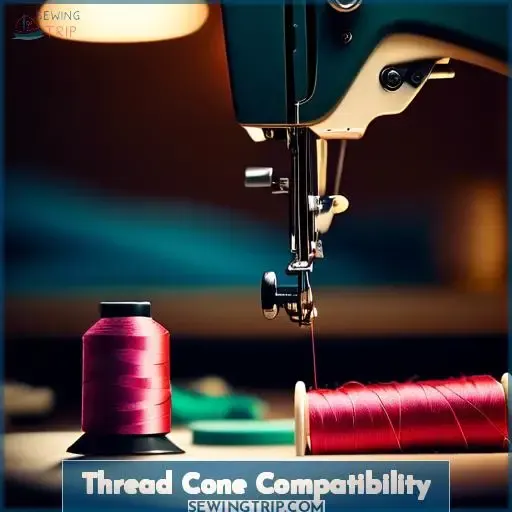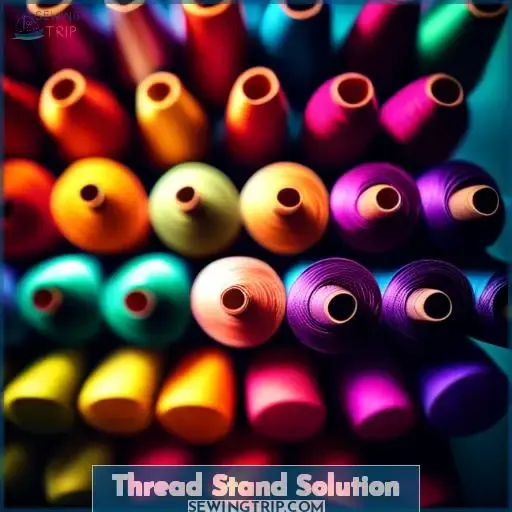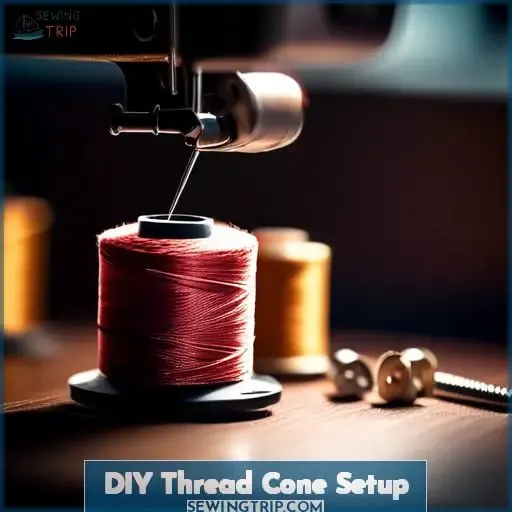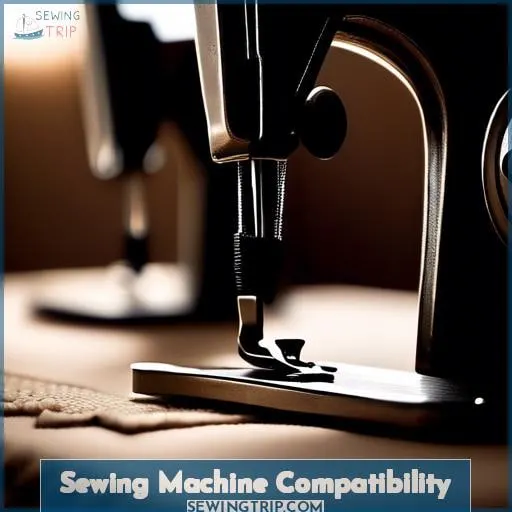This site is supported by our readers. We may earn a commission, at no cost to you, if you purchase through links.
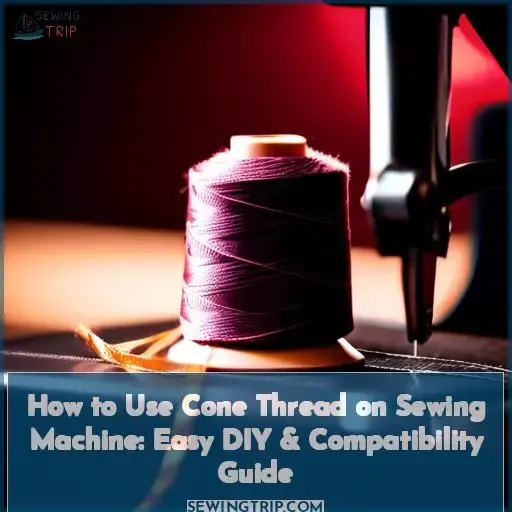 Ever wondered how to seamlessly integrate cone thread into your sewing projects without the hassle? You’re not alone.
Ever wondered how to seamlessly integrate cone thread into your sewing projects without the hassle? You’re not alone.
Cone thread, typically reserved for sergers and industrial machines, offers a cost-effective solution for extensive sewing tasks. This guide demystifies the process, providing easy DIY solutions and compatibility tips for using cone thread on your sewing machine.
Dive into innovative techniques that ensure smooth sewing experiences, elevating your craft to new heights.
Table Of Contents
Key Takeaways
- Cone thread can be used on home sewing machines with some DIY ingenuity, such as using cone thread holders or stands to ensure smooth tensioning and compatibility.
- Thread stand solutions vary from lightweight and affordable plastic stands to more stable and durable metal stands, enhancing sewing efficiency and ensuring smooth operation.
- A DIY thread cone setup can be easily assembled by placing the cone on the floor and looping the thread over a chair, which is a wallet-friendly solution that keeps tension issues at bay.
- It’s important to adjust the tension knob for optimal thread tension, and makeshift solutions like using a coffee cup or a margarine tub as a thread stand can help ensure smooth thread flow and prevent tangles and tension problems.
How to Use Cone Thread on Sewing Machine
To use cone thread on a sewing machine, place the cone on a thread stand behind the machine for smooth feeding, or set it on the floor and guide the thread over a chair. This method ensures consistent tension and compatibility with home sewing machines.
Thread Cone Compatibility
Diving into the world of sewing with large cones can feel like a leap from a kiddie pool into the ocean. But fear not, your home sewing machine can indeed befriend these giants with a bit of DIY ingenuity.
The trick lies in mastering the art of tensioning. Without proper tension, your sewing project might end up looking like it was in a tangle with a cat.
Enter the lifesaver: the cone thread holder or stand. This nifty gadget ensures smooth sailing, allowing the thread to glide like a figure skater across your fabric.
Opting for a DIY setup? It’s like MacGyvering your way to sewing efficiency, turning everyday items into a makeshift cone holder.
Embrace the adventure of using cone thread, and watch your sewing projects transform from good to sew amazing.
Thread Stand Solution
You have options between plastic and metal thread stands, each offering unique benefits for your sewing projects. Choosing the right one can significantly enhance your sewing efficiency, allowing for smoother operation and better results.
Plastic Vs. Metal Options
Choosing between plastic and metal thread stands?
It’s like picking your dance partner for the sewing marathon. Plastic stands, with their lightweight charm, might waltz around a bit, but they’re easy on the wallet.
Metal stands, on the other hand, are the steady, reliable types, offering unmatched stability and durability.
Whether it’s the sleek look of metal or the practicality of a plastic base, your thread cone and guide will thank you.
Enhancing Sewing Efficiency
After choosing between plastic and metal thread stands, you’re on the path to sewing mastery.
A thread stand isn’t just a tool; it’s your ally in the quest for perfect stitches. It tackles big spools with ease, ensuring thread control and tension adjustment are a breeze.
Dive into DIY solutions for thread storage and watch your domestic sewing machine sing with cone compatibility.
DIY Thread Cone Setup
After exploring thread stand solutions, let’s dive into a DIY thread cone setup, a nifty trick for your sewing projects.
Picture this: you’ve got a hefty cone of thread, but your sewing machine seems to scoff at the idea of accommodating it. No sweat! You can create a makeshift holder that’s both wallet-friendly and a cinch to assemble.
Simply place your cone on the floor behind your trusty stitch-wizard, loop the thread over the back of a chair, and voilà! You’ve rigged a path that keeps tension issues at bay. This setup is a testament to cone compatibility and machine harmony, ensuring your heavy thread feeds smoothly without breaking the bank.
Sewing Machine Compatibility
Shifting gears from our DIY thread cone setup, let’s dive into the nuts and bolts of sewing machine compatibility.
It’s like finding the perfect dance partner; not every machine can handle the rhythm of cone thread. Before you waltz into sewing, do a compatibility check. Think of it as a first date with your machine—test out different threads and fabrics to see what clicks.
Your machine’s manual isn’t just for show; it’s your dance instructor, guiding you through the steps of using cone thread without stepping on your machine’s toes. Avoid the dance of tangled thread, false stitches, or worse, a jammed machine, by using a wire hook for smooth guidance.
Thread Tensioning
After ensuring your sewing machine can cozy up to those larger thread cones, it’s time to dive into the nitty-gritty of tension control. Think of tension adjustment as tuning a guitar; it’s all about hitting that perfect note.
- Tweak the Tension Knob: This little dial is your best friend. A slight turn can make a world of difference in preventing those pesky tension problems.
- Use a Coffee Cup: No kidding, a simple mug or even a margarine tub behind your machine can act as a makeshift thread stand, easing the tension spring’s workload.
- Clip it Right: A wooden clothespin can be a game-changer. Clip it onto your machine as a DIY tension gauge, guiding the thread smoothly and keeping tangles at bay.
Frequently Asked Questions (FAQs)
Can cone thread damage my sewing machine?
Cone thread won’t wreck your sewing machine if you play your cards right. Just ensure you’re using a thread stand or a DIY setup to avoid tension mishaps.
How does cone thread affect stitch quality?
Cone thread can be a bit unruly, sometimes causing skipped stitches or tension tantrums, but with the right setup, it’ll have your stitches looking sharp and your wallet feeling happy.
Is cone thread suitable for all fabric types?
Navigating the fabric jungle, cone thread isn’t a one-size-fits-all solution. While versatile, it shines on sturdy materials but may play tug-of-war with delicate fabrics.
Can I interchange different brands of cone thread?
Sure, you can mix and match cone thread brands like a pro DJ blends tunes—just ensure they’re compatible with your machine and fabric to avoid a stitch-pitch mismatch.
Are there eco-friendly options for cone thread?
Yes, there are eco-friendly cone thread options! Brands like Scanfil offer 100% organic cotton threads, while others, such as AMANN, provide threads made from recycled materials.
Conclusion
Just as a key unlocks a door, mastering how to use cone thread on your sewing machine opens up a world of creativity and efficiency in your sewing projects.
By choosing the right thread stand, crafting a DIY setup, ensuring machine compatibility, and adjusting thread tension, you’re equipped to handle any task with precision and ease.
Embrace these techniques to elevate your sewing experience, making every stitch count. Remember, the right tools and knowledge transform challenges into opportunities for innovation.

